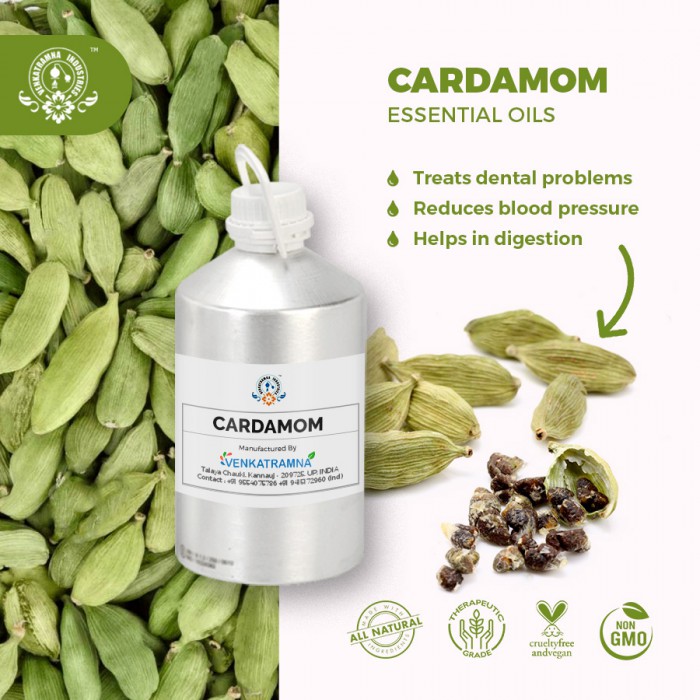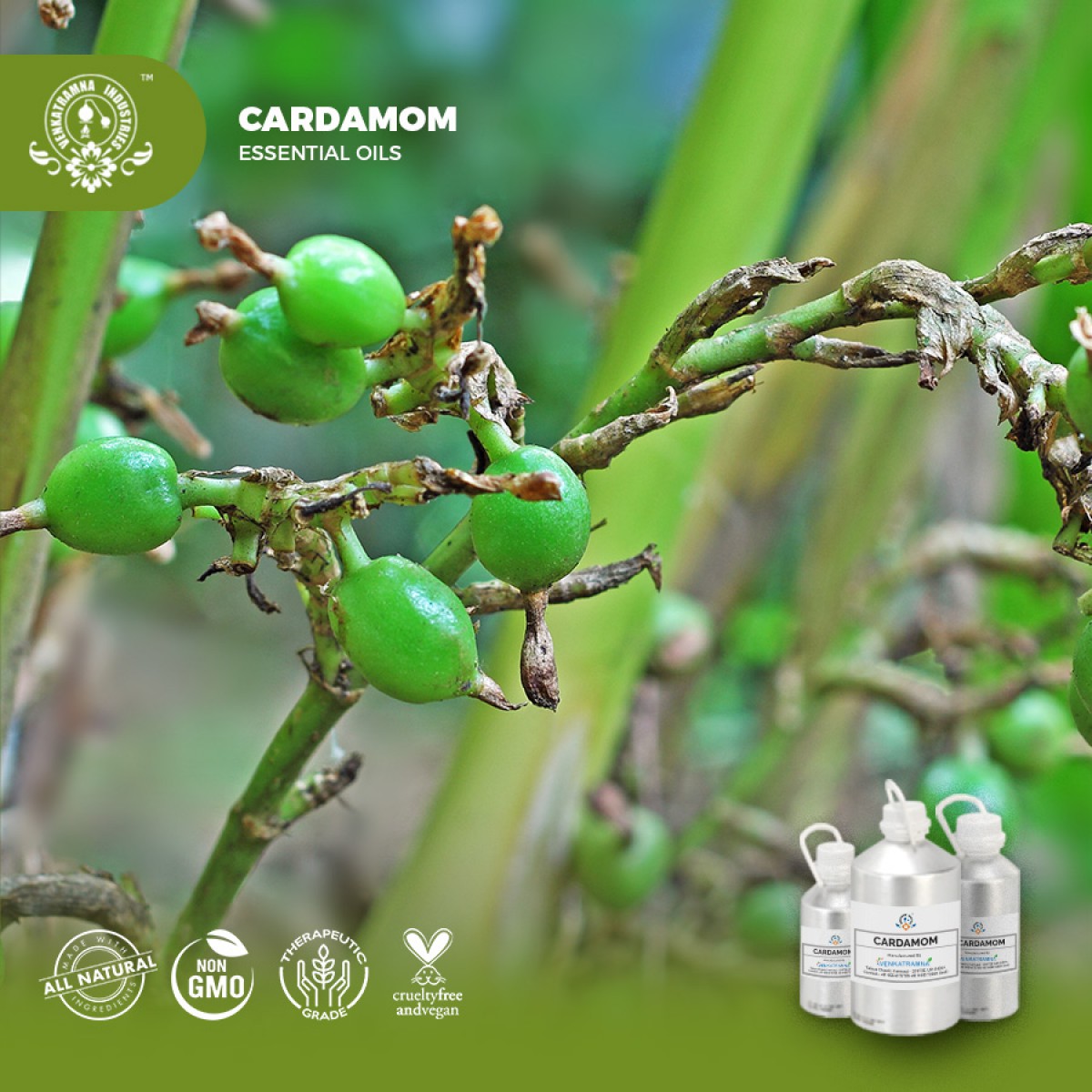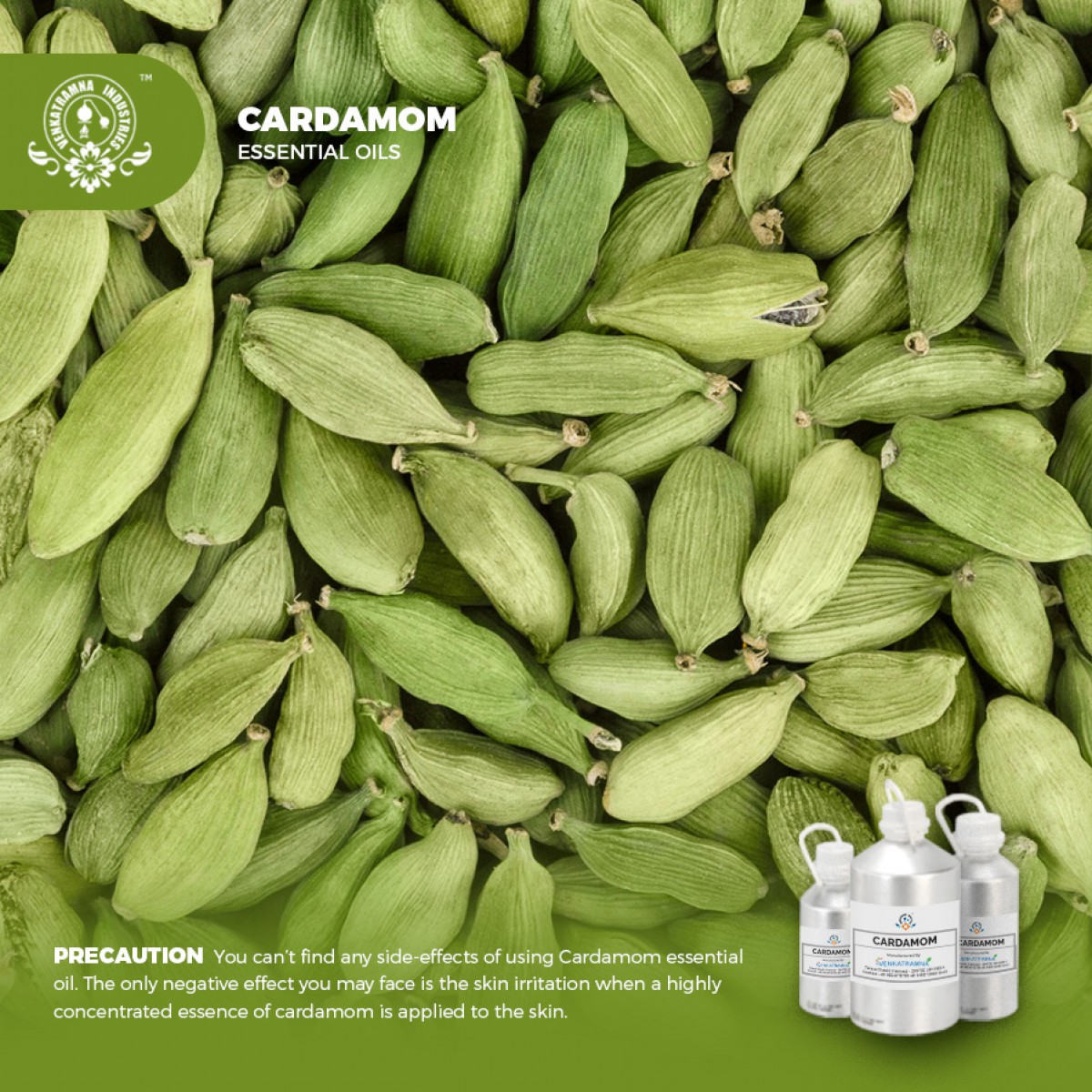Botanical Name : Elettaria cardamomum L. Common name: Cardamon/ Lesser Cardamon, E Read More
|
Botanical Name : |
Elettaria
cardamomum L. |
|
Common name: |
Cardamon/ Lesser Cardamon, Elaichi |
|
Plant family: |
Zingiberaceae |
|
Genus: |
Elettaria |
|
Appearance/Color: |
A light, colourless to very pale yellow liquid. |
|
Odor: |
Cardamom essential oil is a flavorful and distinct product comes
from sweet smelled cardamom seeds. Due to its strong aroma, it has secured a
top note in aroma category. |
|
Blends With: |
It is a versatile essential oil, cardamom oil can easily
be blended with orange, rose, cinnamon Bark , caraway, clove bud and
cedarwood. |
|
Origin |
India |
Cardamom (Elettaria cardamomum)
is a perennial, herbaceous rhizomatous monocot, belonging to the family
Zingiberaceae. It is a native of the moist evergreen forests of the Western
Ghats of South India. The cardamom of commerce is the dried ripe fruit
(capsule) of the cardamom plant. This is often referred to as the 'Queen of
Spices' because of its very pleasant aroma and taste and is highly valued from
ancient times. It is grown extensively in the hilly regions of South India at
elevations of 600-1300 m as an under crop in forest lands. Cardamom is also
grown in Sri Lanka, Papua New Guinea, Tanzania and Guatemala. Guatemala is
incidentally the largest producer of cardamom now.
Cardamom is a major spice crop of
India and improvement of the crop has attracted considerable attention after
independence. The 'Western Ghat forests' of the Malabar Coast of India is the
centre of origin and the primary centre of diversity of cardamom. In ancient
days, cardamom was collected mainly by tribal people as a forest produce.
Later, by the end of 19" century, cardamom plantations came up in Western
Ghat forest areas and also in Ceylon (Sri Lanka). The credit for starting
organized cultivation of cardamom goes to the British planters. Later cardamom
was introduced to Guatemala from Ceylon by 1920s and after the second world war
cardamom production in Guatemala expanded considerably and by 1970s the country
became the largest commercial producer of cardamom eclipsing the monopoly of
India.
Cardamom oil is produced commercially using crushed fruits. It is used mainly as an alternative to the spice for flavouring a wide range of processed and frozen foods, condiments, gelatines and beverages. It is also used to a minor extent as tobacco flavouring, and in cosmetics, soaps, lotions and perfumes. Oleoresin is used as an oil substitute in similar products.
DISCLAIMER
The complete range of conditions
or methods of use are beyond our control therefore we do not assume any
responsibility and expressly disclaim any liability for any use of this
product. Information contained herein is believed to be true and accurate however,
all statements or suggestions are made without warranty, expressed or implied,
regarding accuracy of the information, the hazards connected with the use of
the material or the results to be obtained from the use thereof. Compliance
with all applicable federal, state, and local laws and local regulations
remains the responsibility of the user.
The FDA has not evaluated the
statements on this website. No claims are made by Venkatramna Industries as to
the medicinal value of any products from vriaroma.com or by us. The information
presented here is for educating our customers about the traditional uses of
essential oils and is not intended to diagnose, treat, cure, or prevent any
disease. You are responsible for understanding the safe application of these products.
If you have any questions, please call or email us for further information.
As per NAHA guidelines, New Directions Aromatics (NDA) does not recommend the ingestion of essential oils. It is imperative to consult a medical practitioner before using Essential Oils for therapeutic purposes. Pregnant and nursing women and those taking prescription drugs are especially advised not to use this product without the medical advice of a physician. The oil should always be stored in an area that is inaccessible to children, especially those under the age of 7.
Cardamom is sometimes known as
the 'queen of spices' alongside black pepper, which is known as the 'king of
spices'. The dried ripe fruits of cardamom have been used as a spice and in
medicines since the 4th century BC. The use of cardamom as an aromatic
stimulant is recognised in Britain and Europe, and it is well known for its
stomach-calming properties.
Cardamom Essential Oil in
Pharma
In Ayurvedic medicine, cardamom
is used to treat disorders of the stomach and urinary system, asthma,
bronchitis and heart problems. When mixed with neem and camphor, cardamom is
used as a nasal preparation to treat colds. An infusion of cardamom can be used
as a gargle to relieve sore throats, which has led to its use in cough sweets.
Cardamom seeds have been used in
a range of preparations. Roasted seeds were boiled with betel nuts (fruits of
the palm Areca catechu) to make a drink that is used to treat indigestion
and nausea. They are also added to tea to make a tonic to relieve the symptoms
of stress due to overwork or depression. Cardamom seeds are given to patients
with bad breath and a capsule of cardamom taken with honey is reputed to
improve eyesight. The traditional uses of cardamom to treat skin conditions
have attracted the attention of those developing plant-based cosmetics,
especially as it has been used traditionally to treat areas of the body that
have red-pigmentation. It is often incorporated into soaps and hand creams.
Essence of Cardamom Essential
Oil
Cardamom is used as an important
flavour in a variety of food products, beverages, and oral formulations of
medicines. In addition, cardamom is popular as an after food mouth flavourant
in India. Cardamom essential oil is extracted from the seeds. It is mainly used
in the flavouring of processed foods and drinks such as cordials, bitters and
liqueurs and occasionally in perfumery.Cardamom oleoresin has similar
applications to the essential oil. It is mainly used to flavour meat products
with a short shelf life, such as sausages. Because the oil has antibacterial
activity it has been added to foods as a preservative at low levels. It is used
in low quantities so it does not affect the flavour of the food.
Cardamom is used as a breath
freshener. It is frequently chewed after meals and may sometimes be included as
a flavouring in a betel quid. It is used to a small extent to flavour tobacco.
COMMON USAGE
·
Help in digestion
·
Prevents heart problems
·
Helps in cancer prevention
·
Possessses diuretic properties
·
Effective against repressive
·
Cures asthma
·
Reduces blood pressure
·
Cures diabetes
·
Has anti-inflammatory attributes
·
Acts an anti-spasmodic
·
Treats dental problems
·
Stimulate blood circulation
·
Cures sore throats, nausea and vomiting
Ingredients:
|
S.No |
Key Constituents |
Strength (%) |
|
1 |
1,8-cineole |
26.5-44.6 |
|
2 |
Linalyl acetate |
0.7-7.7 |
|
3 |
a-terpinyl acetate |
29.2-39.7 |
|
4 |
Linalool |
0.4-5.9 |
|
5 |
(P)-limonene |
1.7-6.0 |
|
6 |
Sabinene |
2.5-3.8 |
|
7 |
a-terpineol |
0.8-4.3 |
|
8 |
Terpinen-4-ol |
0.9-3.2 |
|
9 |
b-myrcene |
0.2-2.2 |
|
10 |
(E)-nerolidol |
0.1-2.7 |
|
11 |
a-pinene |
0.6-1.5 |
|
12 |
Geraniol |
0.3-1.1 |
TOXICOLOGICAL
INFORMATION
Safety Summary
·
Hazardous No Data
·
Contraindications Not Known
Organ Specific Effects
·
Not Known
Systemic Effects
·
Acute Toxicity
o
Acute oral toxicity: LD50 orl-rat 5g/Kg FCT 12,
837 (1974)
o
Acute dermal toxicity: LD50 skn-rbt >5g/Kg
FCT 12, 837 (1974)
·
Respiratory sensitization: Not applicable under
normal use.
·
Germ cell mutagenicity: Not specified
·
Carcinogenicity: IARH: No component of this
product present at levels greater than or equal to 0.1% is identified as
probable, possible or confirmed human carcinogen by IARC. ACGIH: No component
of this product present at levels greater than or equal to 0.1% is identified
as probable, possible or confirmed human carcinogen by IARC.
·
NTP: No component of this product present at
levels greater than or equal to 0.1% is identified as probable, possible or
confirmed human carcinogen by IARC.
·
OSHA: No component of this product present at
levels greater than or equal to 0.1% is identified as probable, possible or
confirmed human carcinogen by IARC.
·
Reproductive toxicity: Not specified
·
STOT-single exposure: Not specified
·
STOT-related exposure: Not specified
·
Aspiration hazard: Not specified
ECOLOGICAL
INFORMATION
·
Info summery of Ecological Information Balance
of data on substance, not determined.
·
Toxicity Acute fish toxicity: LC50 / 96 HOUR –
No data available
·
Toxicity to aquatic plants – No data available
·
Toxicity to microorganisms – No data available
Toxicity threshold – No data available
·
Persistence and degradability Biodegradation is
expected
·
Bio-accumulative potential Bioaccumulation is
unlikely
·
Mobility in soil Unknown





 PS-Cardamom.pdf
PS-Cardamom.pdf




